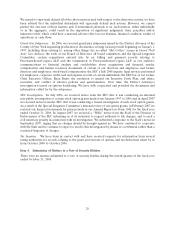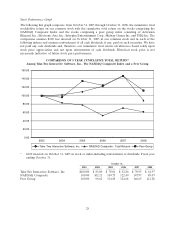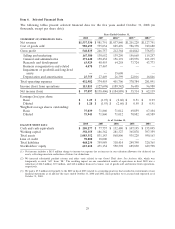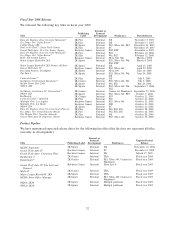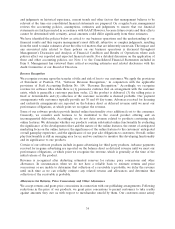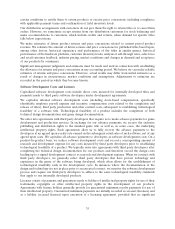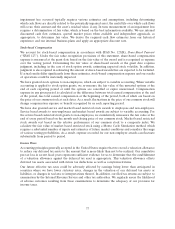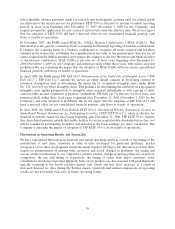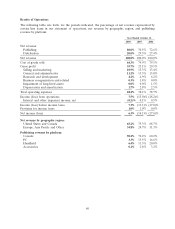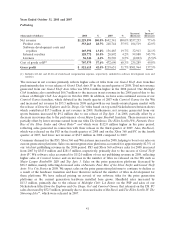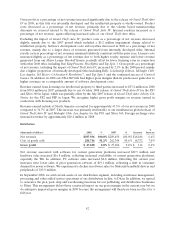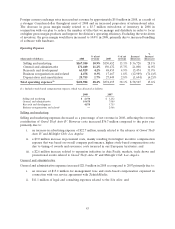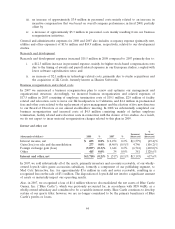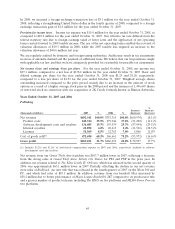2K Sports 2008 Annual Report Download - page 45
Download and view the complete annual report
Please find page 45 of the 2008 2K Sports annual report below. You can navigate through the pages in the report by either clicking on the pages listed below, or by using the keyword search tool below to find specific information within the annual report.certain conditions to entitle them to return products or receive price concessions, including compliance
with applicable payment terms and confirmation of field inventory levels.
Our distribution arrangements with customers do not give them the right to return titles or to cancel firm
orders. However, we sometimes accept returns from our distribution customers for stock balancing and
make accommodations to customers, which include credits and returns, when demand for specific titles
falls below expectations.
We make estimates of future product returns and price concessions related to current period product
revenue. We estimate the amount of future returns and price concessions for published titles based upon,
among other factors, historical experience and performance of the titles in similar genres, historical
performance of the hardware platform, customer inventory levels, analysis of sell-through rates, sales force
and retail customer feedback, industry pricing, market conditions and changes in demand and acceptance
of our products by consumers.
Significant management judgments and estimates must be made and used in connection with establishing
the allowance for returns and price concessions in any accounting period. We believe we can make reliable
estimates of returns and price concessions. However, actual results may differ from initial estimates as a
result of changes in circumstances, market conditions and assumptions. Adjustments to estimates are
recorded in the period in which they become known.
Software Development Costs and Licenses
Capitalized software development costs include direct costs incurred for internally developed titles and
payments made to third party software developers under development agreements.
We capitalize internal software development costs (including stock-based compensation, specifically
identifiable employee payroll expense and incentive compensation costs related to the completion and
release of titles), third party production and other content costs, subsequent to establishing technological
feasibility of a software title. Technological feasibility of a product includes the completion of both
technical design documentation and game design documentation.
We enter into agreements with third party developers that require us to make advance payments for game
development and production services. In exchange for our advance payments, we receive the exclusive
publishing and distribution rights to the finished game title as well as, in some cases, the underlying
intellectual property rights. Such agreements allow us to fully recover the advance payments to the
developers at an agreed upon royalty rate earned on the subsequent retail sales of such software, net of any
agreed upon costs. We capitalize all advance payments to developers as software development costs. On a
product-by-product basis, we reduce software development costs and record a corresponding amount of
research and development expense for any costs incurred by third party developers prior to establishing
technological feasibility of a product. We typically enter into agreements with third party developers after
completing the technical design documentation for our products and therefore record the design costs
leading up to a signed development contract as research and development expense. When we contract with
third party developers, we generally select third party developers that have proven technology and
experience in the genre of the software being developed, which often allows for the establishment of
technological feasibility early in the development cycle. In instances where the documentation of the
design and technology are not in place prior to an executed contract, we monitor the software development
process and require our third party developers to adhere to the same technological feasibility standards
that apply to our internally developed products.
Licenses consist of payments and guarantees made to holders of intellectual property rights for use of their
trademarks, copyrights or other intellectual property rights in the development of our products.
Agreements with license holders generally provide for guaranteed minimum royalty payments for use of
their intellectual property. Guaranteed minimum payments are initially recorded as an asset (licenses) and
as a liability (accrued licenses) upon execution of a licensing agreement, provided that no significant
35



